Enneagram Tri-Center 3-9-5: Heart Type 3, Gut Type 9, Head Type 5
The 3-9-5 Tri-Center
-
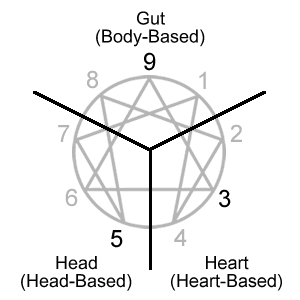
Your tri-center consists of your dominant type in each of the three centers of intelligence with a preferred ordering of the centers (types). The preferred ordering of the 3-9-5 is:
Heart Type: Type 3
-
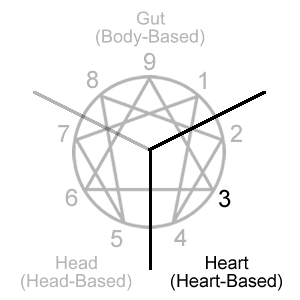
Type 3 is located in the 234 triad which is often described as the heart or heart-based center.
The heart types are focused on interpreting, expressing, and reacting to one’s own emotions or the emotions of others. More specifically, the heart center focuses on what's emotionally significant in the sense that emotions are an indication of how strongly a person resonates with or against something or someone.
This may involve being attentive to the emotional needs and desires of others, seeking emotional affirmation for oneself from others, and expressing one's own unique emotional impression of the world.
Type 3 often puts aside personal feelings that might get in the way of pursuing goals. Yet, they may also seek emotional affirmation or validation through recognition from others. Although accomplishments and the overcoming of challenges on their own can increase a sense of self-esteem, it can be hard to know how well they are performing without some external indicator, such as awards or recognition, to affirm their effort and value.
Type 3 Shame
The shame triad consists of types 2, 3, and 4. Shame for these types involves the heart center. It can be thought of as a feeling of deficiency for not living up to a more idealized sense of self.
This may involve initiating connection with others to avoid feeling unlovable or unimportant in the lives of others, finding value and worth through performance and accomplishment, and finding significance by cultivating and expressing one's uniqueness.
Type 3 shame can come from a sense of failure in achieving a goal or gaining recognition. Although failures can sometimes be spun as simply lessons to be learned or simply a speedbump along the way to success, there can also be an avoidance of pursuing endeavors that risk failure in favor of those with less risk.
To learn more about Enneagram personality type 3 click here.
Gut Type: Type 9
-

Type 9 is located in the 891 triad which is often described as the gut or body-based center.
There are several ways to interpret what the gut or body types represent. They may be thought of in terms of sensory-somatic (bodily felt sensation), sensory-motor (physical movement and activity), or instinctual (gut decision making).
This may involve taking action based on one's gut instinct, getting pulled along by the agenda of others, and actively trying to correct what's seen as wrong in the world.
Type 9 often seeks physical comfort and routine. There can be an inertia when it comes to physical activity. When at rest they tend to stay at rest and when moving they tend to maintain that movement. In other words, they may stubbornly resist doing what they don't want to and fall into routines which they dislike having interrupted. They often have difficulty setting and following through on personal goals. Instead, there can be a tendency to get carried along on the energy and agenda of others.
Type 9 Anger
The anger triad consists of types 8, 9, and 1. Anger for these types involves the gut or body center. It can be thought of as an energy of will that pushes against obstacles to create movement or resists being pushed.
This may involve pushing through obstacles to get what one wants, stubbornly resisting attempts to be pushed in an undesired direction, and getting people to see what's right and correcting things not done right.
Type 9 is said to fall asleep to their anger. Because they generally don't have a strong personal agenda, they tend to simply go along to get along instead of making an effort to overcome obstacles in pursuit of a goal. However, they can push back in resistance, through a stubbornness or passive-aggressiveness, when they are confronted to do something they don't want to.
To learn more about Enneagram personality type 9 click here.
Head Type: Type 5
-

Type 5 is located in the 567 triad which is often described as the head or head-based center.
Although the head types can be thought of in terms of reasoning, analyzing, and other typical thinking functions, a useful distinction from the other two centers can be made in terms of anticipating and preparing for future possibilities.
This may involve gathering data and facts in order to better predict outcomes, preparing for negative potentialities that might occur, and planning or pursuing activities that provide enjoyment and avoid discomfort.
Type 5 mentally observes and analyzes from the sidelines of a situation. It's an attempt to understand what's going on before stepping in and participating, having a mental map of sorts to navigate the situation. It not only minimizes effort by being more efficient when taking action but also creates a role for type 5 to play by having knowledge to draw from. This mental objectivity may also be used to detach from any emotions at hand that might otherwise be overwhelming.
Type 5 Fear
The fear triad consists of types 5, 6, and 7. Fear for these types involves the head center. It can be thought of as a negative anticipation of future possibilities and wanting to prepare for or avoid those possibilities.
This may involve learning as much as possible in order to feel competent and knowledgeable, imagining worst-case scenarios and preparing for them, and having alternatives available to avoid being trapped in discomfort or pain.
Type 5 fear is of being overwhelmed and not knowing enough to feel competent. They need time and space to process experiences. However, the world often doesn't allow for that. This can leave the type 5 feeling overwhelmed. Having the knowledge and competence beforehand eases that feeling.
To learn more about Enneagram personality type 5 click here.
3-9-5 Tri-Center Focus
-
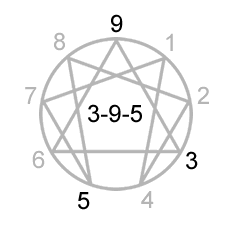
Striving-Accommodating-ObservingThe tri-center focus looks at your dominant type in each center through the core focus.
-
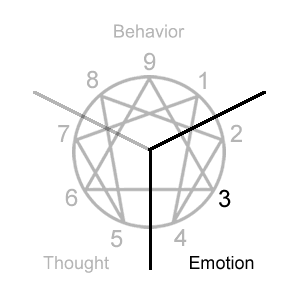
Type 3 Initial Self-Belief: “I am not valued as I am.”
Type 3 Compensation: "I must become accomplished and prove myself to gain value and regard in the eyes of others."
Type 3 Core Focus: Esteem comes from being valued and having the positive regard of others. This requires that I not only package myself and perform in ways that will garner that recognition and positive regard but also find ways of measuring my success toward those ends.
Personality characteristics that might arise from the type 3 core focus:
- Looks to external indicators for how well they're performing.
- Packages and markets self-image that's admired by intended audience.
- Pushes aside feelings that get in the way of achieving goals.
- Sense of self-value comes from what they produce or accomplish.
- Competes in arenas where there is someone to beat and someone to notice.
- Chamelon-like shifts of image occur to match situational expectations.
- Confuses self-presentation with who they truly are.
- Avoids failure by avoiding pursuits where failure is a possibility.
- Gives priority to goals and achieving them over other things.
-

Type 9 Initial Self-Belief: “I am not in unity as I am.”
Type 9 Compensation: "I must accommodate others' agenda and opinions in order to feel at ease and in harmony with them."
Type 9 Core Focus: Harmony comes from getting along with others and falling into comfortable routines. This requires that I accommodate others by finding common ground and minimizing my own agenda when around others as well as finding comfort and peace of mind for myself.
Personality characteristics that might arise from the type 9 core focus:
- Loses sight of own agenda in favor of the agenda of others
- Smooths over conflict in order to keep the peace and feel more at ease
- Has difficulty establishing goals and following through on them
- Struggles with inertia: getting going or changing course once underway
- Gets lost in peripheral activities that don't serve the primary objective
- Avoids creating separation from people by going along to get along
- Supresses anger which may surface as stubbornness or passive-aggressiveness
- Finds it difficult to prioritize because everything can seem equally important
- Numbs themself through comfort seeking and getting lost in routine
-
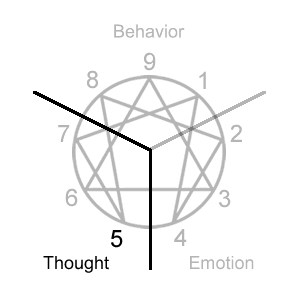
Type 5 Initial Self-Belief: “I am uninformed as I am.”
Type 5 Compensation: "I must objectively observe the world as it is in order to clearly make sense of and navigate it."
Type 5 Core Focus: Comprehension comes from objectively observing the world and logically distilling the facts. This often requires that I detach from experiences as they happen in order to see things clearly and not feel overwhelmed. I need time and space to later process those facts and experiences.
Personality characteristics that might arise from the type 5 core focus:
- Narrows area of interest to specialized niche
- Minimizes needs to avoid dependency on others
- Guards against intrusions upon privacy
- Lives life from the sidelines instead of fully participating
- Withdraws when feeling overwhelmed by people
- Postpones action in favor of more research and analysis
- Detaches from emotions by going into the head
- Delays experiencing life in the moment, rehashing it when alone
- Requires time to think and reflect before responding
Heart Focus: Emotional Ambition
Type 3 - Esteem through Emotional Ambition
Gut Focus: Behavioral Accommodation
Type 9 - Harmony through Behavioral Accommodation
Head Focus: Mental Observation
Type 5 - Comprehension through Mental Observation
To learn more about the centers and your center types click on a link below.
Enneagram Tests to Help Determine Centers

The Enneagram personality types group the nine types into three centers of intelligence often referred to as the gut, heart, and head centers.
These tests help you find your dominant type in each center and the order of preference for those centers.
-
Dominant Type in Each Center with Wings Test
This test determines your dominant type in each center (aka tri-center, trifix, tritype, truetype) along with the wings of those types.
Use when you want to know your tri-center or tri-center with wings. -
Enneagram Type Preference Test
This test produces a scored list of all nine types.
Questions are forced-choice, similar to the method used by the Riso-Hudson Enneagram Type Indictor (RHETI).
Use to determine type, wings, gut/heart/head types, and tri-center. -
Center Type Comparison Test
This test scores the three types in a given center to determine your dominant type within that center (gut, heart, or head type).
Use when you don't know your dominant type for one of the centers. -
Type Comparison Test
This test compares any two types, producing a score for each.
Use when unsure of your tri-center order or which of two types is preferred for a center.
Click here for the Complete Guide to the Enneagram.
This free guide explains- the nine Enneagram personality types
- the many type variations within type
- where the types came from (origins and history)
- how the types use the Enneagram symbol
Click here for Enneagram tests.
These free tests help you find your- primary type
- candidate types
- preferred wing
- intinctual subtype
- instinctual variant stacking
- center types (gut, heart, and head)
- tri-center with wings